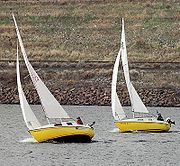
San Juan 21
Encyclopedia

One-design
One-Design is a racing method where all vehicles or boats have identical or very similar designs or models. It is also known as Spec series. It is heavily used in sailboat racing. All competitors in a race are then judged based on a single start time...
sailboat
Sailboat
A sailboat or sailing boat is a boat propelled partly or entirely by sails. The term covers a variety of boats, larger than small vessels such as sailboards and smaller than sailing ships, but distinctions in the size are not strictly defined and what constitutes a sailing ship, sailboat, or a...
featuring a swing keel
Keel
In boats and ships, keel can refer to either of two parts: a structural element, or a hydrodynamic element. These parts overlap. As the laying down of the keel is the initial step in construction of a ship, in British and American shipbuilding traditions the construction is dated from this event...
, normally sailed with a crew of two or three. The San Juans were made to compete with the J Boats as a racer/cruiser but the J Boats were better, eventually driving The Clark Boat Company, which produced the San Juans, out of business.
The San Juan 21 blends a combination of performance and ease of sailing. They are very easy to set up and can be put in the water in as little as 25 minutes. With the swing keel, they ride low on the trailer and can be launched and retrieved from any ramp. A handful of fixed-keel variants were produced, including a small number of shoal keel models. It is believed that fewer than 300 fixed-keel boats were produced, and even fewer of the shoal-keel boats (believed to be less than 20). Clark experimented with the fixed-keel design predominantly in the production plant located near Seattle, Washington.
They handle much like big dinghies, yet with the 400-lb. keel, they are self righting. This is not of much concern, as capsizing a San Juan 21 is not easy. Initially tender, the San Juan 21 heels to 15 degrees rather easily but firms up there, and once past 40 degrees, the helmsman has to make a rather big mistake to get it to go more. Once past 50 degrees or so, the sturdy little boat will round up and head into the wind.
The San Juan 21 is a pleasure to sail for both novices and experienced racers. Due to its light weight (1500 lb or so), it accelerates briskly in puffs and will literally sail rings around most bigger boats in light to moderate winds. There are several one-design class fleets located at various lakes across the country with active racing schedules all summer. While designed more with performance in mind, the boat is comfortable for weekend cruising for two adults with two small children. It has space for a camping toilet and ample storage for other essentials.
They are also easy to single-hand
Single-handed sailing
The sport of single-handed sailing or solo sailing is sailing with only one crewmember . The term is usually used with reference to ocean and long-distance sailing, and particularly competitive sailing....
, with the fractional rig’s small jib
Jib
A jib is a triangular staysail set ahead of the foremast of a sailing vessel. Its tack is fixed to the bowsprit, to the bow, or to the deck between the bowsprit and the foremost mast...
and large main.
The other factor that surprises a lot of people is the low cost of ownership. Good condition boats can be had for $2,000 to $3,500, and yearly maintenance can be as little as $350 a year, which includes saving up for new sails every 5 years.
The sail inventory consists of a large mainsail, a small 110% working jib, a 135% genoa, and a spinnaker
Spinnaker
A spinnaker is a special type of sail that is designed specifically for sailing off the wind from a reaching course to a downwind, i.e. with the wind 90°–180° off the bow. The spinnaker fills with wind and balloons out in front of the boat when it is deployed, called flying. It is constructed of...
. Being a one-design class, rules limit the sails to be made from Dacron and the spinnaker from nylon. This keeps costs down.
The San Juan 21 was produced from 1969 to about 1984 with over 2,600 produced. There are three models, the Mark I, Mark II and Mark III
Specifications
Capsize Ratio 2.45
Hull Speed 5.5 knots
Sail Area/Displacement 23.2
Displacement To LWL 136
Length Water Line/Beam 2.429
Motion Comfort 9.55
Length overall: 20 ft 6 in
Length on waterline 17 ft 0 in
Beam 7 ft
Fractional (7/8) rig
Sail area (main and 200%) 190 sq ft (Class genoa is a 130%; in PHRF or cruising most people also have a 155%)
Spinnaker: 284 sq ft (estimate from dimensions)
Mast height: 25 ft 8 in
Draft (keel down) 4 ft 0 in
Draft (keel up) 1 ft 0 in
Displ (class minimum): 1400 lb
Keel weight: 420 lb
PHRF Rating: 252 sec/mile (w/spinnaker) 264 sec/mile (working sails)
Number built approximately 2,700
I 22.5
P 23.00
J 8.00
E 8.75
sailboatdata.com

